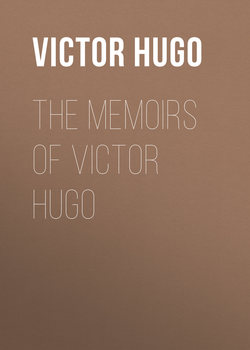Читать книгу The Memoirs of Victor Hugo - Victor Hugo, Clara Inés Bravo Villarreal - Страница 7
VISIONS OF THE REAL
IV. THE PANEL WITH THE COAT OF ARMS
ОглавлениеThe panel which was opposite the bed had been so blackened by time and effaced by dust that at first he could distinguish only confused lines and undecipherable contours; but the while he was thinking of other things his eyes continually wandered back to it with that mysterious and mechanical persistence which the gaze sometimes has. Singular details began to detach themselves from the confused and obscure whole. His curiosity was roused. When the attention becomes fixed it is like a light; and the tapestry growing gradually less cloudy finally appeared to him in its entirety, and stood out distinctly against the sombre wall, as though vaguely illumined.
It was only a panel with a coat of arms upon it, the blazon, no doubt, of former owners of the château; but this blazon was a strange one.
The escutcheon was at the foot of the panel, and it was not this that first attracted attention. It was of the bizarre shape of German escutcheons of the fifteenth century. It was perpendicular and rested, although rounded at the base, upon a worn, moss covered stone. Of the two upper angles, one bent to the left and curled back upon itself like the turned down corner of a page of an old book; the other, which curled upward, bore at its extremity an immense and magnificent morion in profile, the chinpiece of which protruded further than the visor, making the helm look like a horrible head of a fish. The crest was formed of two great spreading wings of an eagle, one black, the other red, and amid the feathers of these wings were the membranous, twisted and almost living branches of a huge seaweed which bore more resemblance to a polypus than to a plume. From the middle of the plume rose a buckled strap, which reached to the angle of a rough wooden pitchfork, the handle of which was stuck in the ground, and from there descended to a hand, which held it.
To the left of the escutcheon was the figure of a woman, standing. It was an enchanting vision. She was tall and slim, and wore a robe of brocade which fell in ample folds about her feet, a ruff of many pleats and a necklace of large gems. On her head was an enormous and superb turban of blond hair on which rested a crown of filigree that was not round, and that followed all the undulations of the hair. The face, although somewhat too round and large, was exquisite. The eyes were those of an angel, the mouth was that of a virgin; but in those heavenly eyes there was a terrestrial look and on that virginal mouth was the smile of a woman. In that place, at that hour, on that tapestry, this mingling of divine ecstasy and human voluptuousness had something at once charming and awful about it.
Behind the woman, bending towards her as though whispering in her ear, appeared a man.
Was he a man? All that could be seen of his body – legs, arms and chest – was as hairy as the skin of an ape; his hands and feet were crooked, like the claws of a tiger. As to his visage, nothing more fantastic and frightful could be imagined. Amid a thick, bristling beard, a nose like an owl’s beak and a mouth whose corners were drawn by a wild-beast-like rictus were just discernible. The eyes were half hidden by his thick, bushy, curly hair. Each curl ended in a spiral, pointed and twisted like a gimlet, and on peering at them closely it could be seen that each of these gimlets was a little viper.
The man was smiling at the woman. It was disquieting and sinister, the contact of these two equally chimerical beings, the one almost an angel, the other almost a monster; a revolting clash of the two extremes of the ideal. The man held the pitchfork, the woman grasped the strap with her delicate pink fingers.
As to the escutcheon itself, it was sable, that is to say, black, and in the middle of it appeared, with the vague whiteness of silver, a fleshless, deformed thing, which, like the rest, at length became distinct. It was a death’s head. The nose was lacking, the orbits of the eyes were hollow and deep, the cavity of the ear could be seen on the right side, all the seams of the cranium could be traced, and there only remained two teeth in the jaws.
But this black escutcheon, this livid death’s head, designed with such minuteness of detail that it seemed to stand out from the tapestry, was less lugubrious than the two personages who held up the hideous blazon and who seemed to be whispering to each other in the shadow.
At the bottom of the panel in a corner was the date: 1503.
